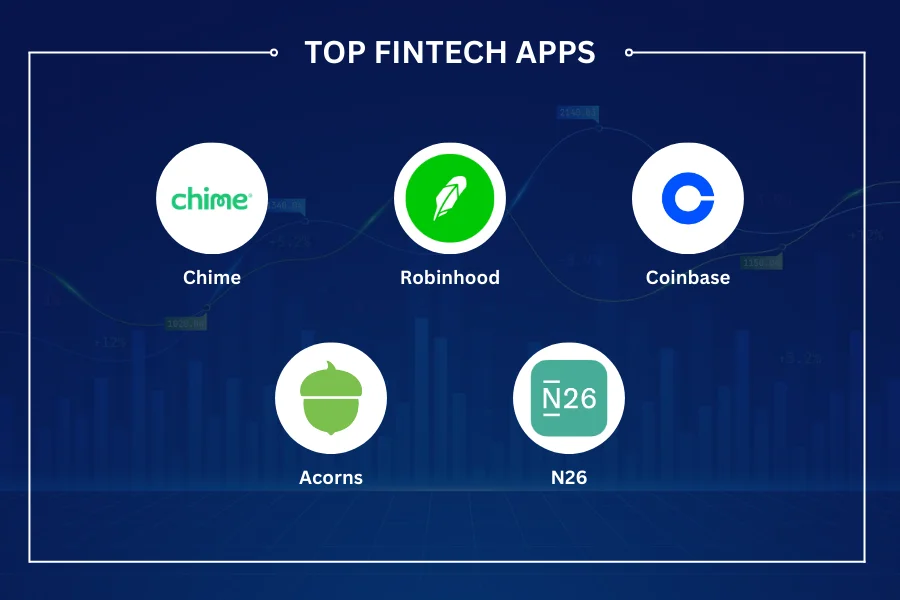Fintech is one of the fastest-growing fields of all time. Businesses from all walks of life have either shown interest or have already advanced towards expanding their presence in fintech.
You might be amazed to know that the current fintech market in 2025 is valued at $394.88 billion, on track to touch $1,126.64 billion by 2032, with a CAGR of 16.2%.
Interesting and motivating stat, right? Well, that’s just the tip of the iceberg!
If you are interested in entering this lucrative market, note that this is not the only stat that makes the fintech market worth investing in.
In this post, let us take a look at some of the core fintech stats and market trends that can give you clarity on whether you should invest in the field or not.
Without further ado, let’s get started!
Global Fintech Market Statistics: An Overview
The current fintech market is definitely one of the best ones to enter if you are planning to launch a profitable business.
The market is growing steadily, making fintech one of the most lucrative niches.
For those who are unfamiliar, financial technology is a niche that has revolutionized the way people interact with financial services, simplifying the experience with the help of technology.
With financial services being the heart of every other business, it only makes sense that the market that involves technology and financial services will grow.
To give you some perspective, here are some of the top fintech statistics that can be called the highlights of the market –
- The fintech as a service (FaaS) market is expected to grow at a CAGR of 16.28% between 2025 & 2034.
- Asia Pacific is expected to be the fastest-growing region for fintech growth between 2025 and 2034.
- The average consumer adoption rate for fintech services is around 64%, making it a growing market.
- The number of digital wallet users was estimated at 4.3 billion in 2024 and is expected to reach 8 billion by 2029.
- Digital payments are a key growth driver estimated at $114.41 billion in 2024 and expected to touch $361.30 billion by 2030 with a CAGR of 21.4%.
- AI in fintech, open banking, Blockchain, and other top fintech trends have appeared, with a vast adoption rate.
- Stripe, Visa, & Tencent are some of the biggest and fastest-growing players in the current fintech market.
- Visa leads the fintech landscape, commanding a valuation nearing half a trillion USD. Fintech unicorns, numbering 48, hold a market share surpassing $187 billion, constituting over 1% of the worldwide financial industry.
With all these highlights, you might have gotten an idea about how lucrative the current fintech market is. In the next sections, let’s take a closer look at more fintech statistics that will help you out!
Fintech Statistics for E-Wallet, Neobanking, and Digital Lending Markets
When talking about fintech statistics, it is important to take into consideration the various niches that it consists of. Fintech has an array of subcategories that businesses generally tend to enter.
Some of the most popular niches that businesses today are interested in include E-wallet, Loan Lending, Mobile Banking, BNPL, and more. Here are the stats to help you understand their market situation better –
► eWallet Statistics
E-wallets and digital wallets are growing rapidly as e-commerce and other services have opted for integrated wallets to improve the transaction experience for users. The rise in the usage of these digital wallets is evident through the usage and market stats. Key stats for the same are as follows:
- The global transaction value for digital payments is estimated to touch $38.07 trillion by 2030.
- 84% of users prefer e-wallets for Peer-to-Peer transfers.
- Alipay & WeChat Pay show the most successful regional dominance of eWallet app development in China, contributing to 90% of all the transactions in the country.
- Cross-border transactions have grown by 45% with the implementation of e-wallets.
► Digital-Lending Statistics
Digital-lending growth in the 2023 to 2025 period in the U.S. market is projected to be an average of 25.1% increase, which prompts a surge in the mortgage origination volume is projected to reach $2.3 trillion in 2025.
Some more key digital lending stats are as follows:
- The total digital lending market value is estimated to be worth $507.27 billion in 2025.
- Consumer lending is currently the leading segment, contributing 61.43% of the lending market share.
- North America currently holds the dominance in the overall digital lending market (as estimated in 2024).
- AI in digital lending is the fastest-growing tech trend in 2025, with AI-driven underwriting processes controlling 44.19% of the market.
► Neobanking Statistics
Neobanking is one of the best concepts introduced through fintech innovation. Incorporating mobile banking and allowing non-traditional banking businesses to enter the market, Neobanking offers direct mobile banking services and makes things better for the users.
- The global neobanking market size is expected to touch $1,228.17 billion by 2029.
- Europe has seen the highest penetration globally with 80 million users, contributing to 40% of the total users.
- Chime and Varo from the US, and Revolut from Europe & the UK, remain the top players in their respective regions.
- More than 75% of neobank customers belong to Millennials & Gen Z.
With all these niches on the rise, it is only fitting that more and more businesses turn their attention to fintech niches and explore the growth opportunities.
Several companies have already made their move and are enjoying great returns. Let’s take a look at some of them in the next section.
Top FinTech Companies with Their Statistics
The market is filled with top fintech apps that are generating billions in the market and top companies that are making even more.

Well, in this section of the fintech app data statistics, let’s look at the top companies.
1. Chime
Chime is among the best banking apps in the market. Let’s go through some Chime statistics to gain insight.
- Chime has a current market valuation of $32 billion.
- Boasting an estimated user base of 25 million users, Chime currently has 8.6 million active users.
- The age group of 35-44 years represents the largest chunk of Chime’s users at 27.62%.
2. Robinhood
Who doesn’t want to create a platform like Robinhood? Well, let’s see how well it is doing with Robinhood statistics:
- The platform boasted 26.5 million funded users in Q2-2025.
- With a significant user base increase, Robinhood reported $989 million in revenue in Q2-2025..
- The number of Robinhood Gold Subscribers is up by 75% (year-over-year) at 3.2 million users.
3. Coinbase
Coinbase is an absolute example of a potential cryptocurrency app development. Let’s see what Coinbase statistics show us:
- Coinbase Global Inc. has a market capitalization of $81.75 billion (as of Q2-2025)
- 7 million users do monthly transactions on Coinbase.
- Coinbase, with over 3,400 employees, serves 9 million active users who transact monthly.
4. N26
N26 statistics below give us a great insight into the fintech startup statistics.
- N26 experienced a 30% year-on-year revenue increase, reaching €130 million in 2020.
- Over seven million individuals utilize N26’s services across 24 countries.
- The most recent valuation for N26 stands at $9 billion, supported by Third Point Ventures and Coatue Management.
5. Revolut
Revolut is an interesting concept that has garnered massive attention in recent years.
- Revolut currently has 60 million+ customers around the world.
- The current valuation as of September 2025 was estimated at $75 billion.
- In just a year, from 2024 to 2025, the brand experienced a massive 38% increase in its overall customer base.
While these brands may come from different niches of the fintech realm, the growth stats clearly indicate the market opportunities and users’ perception of these services.
Clearly, it is important for any business to have an understanding of the market before entering it, however, the fintech stats are highly motivating and give quite a transparent picture of the industry.
Additional Fintech Market Stats for Deeper Insights
The market capitalization of Visa has a market cap of $547 billion in 2024, with an average of 64% of consumers adopting fintech services globally, and in the United States, the average is 46%.
A survey of the respondents by Forbes revealed that a significant majority (74.4%) is likely to use financial products offered by prominent tech figures.
Additionally, tech giants are better equipped to meet consumers’ banking needs than traditional financial institutions.
- Visa stands as the fintech giant, reigning supreme with an impressive market cap of $500 billion.
- Following is Mastercard, securing the second spot with a large valuation of $389 billion.
- Over 25 fintech companies have achieved the coveted “Decacorn” status, surpassing the $10 billion valuation mark.
- The United States dominates the fintech landscape, housing half of the top 20 companies by market cap.
- Of the top 20, nine fintech powerhouses hail from the United States, showcasing the country’s fintech prowess.
- China, with only two companies in the top 20, claims the third and fifth positions based on market cap.
- The United Kingdom hosts two fintech companies within the elite top 20.
- Other countries making their mark include Ireland, Brazil, the Netherlands, India, Israel, Singapore, and Luxembourg, each contributing one fintech company to the prestigious list.
FinTech Startups Statistics
The market is filled with fintech ideas for startups. But what do the fintech startup statistics tell us? Well, we will be discussing that in this section of the fintech report.
[A] FinTech Startup Numbers Hit 30,000
Fintech Startup Statistics from Exploding Topics shows us that there are a total of 30,000 fintech startups today.
Most of these startups are based around payments, lending, and investment.
This clearly shows how there are so many people who want to create their own fintech solutions app for start-ups.
[B] The average age of a FinTech Founder is 34 years old
Did you know that most fintech founders are middle-aged?
Well, fintech statistics from various sources show us that the average age of a fintech founder is no more than 34 years.
This shows that the fintech industry is being driven by a new generation of entrepreneurs.
So, if you have an idea for a fintech app, go ahead and reach out to an app development company that can help you convert it into reality.
[C] 29,955 Startups as of 2025, Showing FinTech Statistics across the world
As of 2024, there are 10,696 Fintech Startups in the EMEA region. Europe comes at the top with 9,200 FinTech startup companies in the EMEA region.
There are over 13,100 fintech startups in the United States. In 2024, the global fintech landscape continued to be dominated by North America, which hosts more than 12,000 fintech companies, a modest increase from 2023.
This steady growth highlights the vibrant and diverse fintech ecosystem in the region, largely driven by the scale and maturity of the U.S. fintech market.
This large number underscores the United States’ position as a leading hub for innovation and entrepreneurship in the financial technology sector.
Interesting FinTech Adoption Statistics
Fintech has experienced immense growth in the past few years; however, it has been around for over a decade now. Understanding the adoption is really important to identify the evolving market perception. Here are some of the crucial stats from earlier years and today to help you understand the adoption rate –
- In 2019, the fintech market in the United States experienced a large surge in investment, reaching over $26 billion.
- Fintech data statistics reflect the increasing confidence and financial backing of the sector, showcasing its significance in the overall market
- In response to the need for efficiency and cost reduction, banks embraced chatbots, anticipating savings of $7.3 billion in 2023, as shown in fintech data statistics.
- The strategic integration of technology not only enhances operational efficiency but also positions chatbots as a cost-effective solution for financial institutions
- Half of financial institutions have embraced fintech, integrating it into their operational strategies.
- These fintech growth statistics emphasize the sector’s growing influence in reshaping traditional financial services and underscore its integral role in modern banking operations.
- In 2021, the Indian fintech ecosystem saw remarkable growth, yielding 15 unicorns valued at over $1 billion each. Thanks to the growing popularity of UPI payment app development.
- The total investment of $8 billion underscores the robust investor confidence and the thriving innovation in India’s fintech sector.
The financial services market is poised for large growth, with a projected CAGR of 9.6%.
By 2026, the market is expected to reach a value of $37 billion, reflecting ongoing expansion and opportunities within the global fintech landscape.
♦ FinTech firms surged from $48.9 billion in 2020 to $131.5 billion in 2021 in Global VC investment
The fintech sector experienced a remarkable influx of venture capital, escalating from $48.9 billion in 2020 to an impressive $131.5 billion in 2021.
This substantial increase underscores the attractiveness and growth potential of fintech innovations in the eyes of investors.
♦ 1 in 10 holds some type of cryptocurrency
Cryptocurrency adoption is becoming widespread, with one in ten individuals holding some form of digital currency.
AI-based Fraud detection systems reduce fraud investigation time by 70% and also increase accuracy by 90%.
The integration of AI-powered fraud detection systems showcases the industry’s commitment to enhancing security measures, reducing investigation time, and improving accuracy.
♦ The worldwide fintech market is projected to reach $188 billion by 2024
Fintech market statistics show significant growth, expanding from a valuation of $90.5 billion in 2017 to a projected $188 billion by 2024.
This trajectory signifies the industry’s evolution and increasing relevance in the global financial landscape.
♦ North America accounted for 56.3% of global fintech VC funding in Q1 2021
In the first quarter of 2021, North America emerged as the dominant force in fintech venture capital funding, securing 56.3% of the global funding, according to US fintech statistics.
This underscores the region’s leadership and attractiveness for investors in the fintech startup ecosystem.
♦ 90% of Chinese citizens use fintech banking, payment, and financial management solutions
China leads in fintech adoption, with a staggering 90% of its citizens utilizing fintech solutions for banking, payments, and financial management.
This fintech statistic reinforces China’s frontrunner position in embracing financial technology across various sectors.
♦ In the US, personal loan agreements using fintech have increased by 33%, while 65.3% of the population uses digital banking as of 2022
Fintech’s impact is evident in the US, with a significant increase in personal loan agreements and a growing percentage of the population adopting digital banking.
The shift towards digital financial services continues to reshape the banking landscape in the United States.
♦ Number of FinTech Companies by Country
The global fintech map is dotted with a diverse array of companies, with the US and China as clear frontrunners. The US takes the top spot with over 8,000 fintech firms, while China boasts a vibrant scene of around 5,000.
Europe, with its bustling tech hubs in the UK and Germany, contributes 4,000, highlighting its innovation prowess.
Global FinTech Industry Report: Emerging FinTech Segments
Fintech is a broad industry. Various fintech reports show various new niches gaining popularity. So let’s see what the global fintech industry report says.
► InsurTech Statistics
Do you want to launch an insurance app?
With the growing popularity of InsurTech App Development, some do. Let’s look at the insurtech statistics.
- The InsurTech sector is poised to hit $26.8 billion by 2027, with a robust 12.7% CAGR, according to Statista.
- Parametric insurance and P2P platforms tackle underinsured areas like cyber risk and climate change, driving alternative risk transfer solutions.
- InsurTech startups are bridging the insurance gap in developing nations with mobile-based solutions and micro-insurance products.
- Stricter regulations loom as concerns about data privacy and algorithmic bias grow, prompting increased scrutiny of InsurTech companies.
► Artificial Intelligence in FinTech
AI solution development has become a popular concept and has been adopted by various industries, including fintech startups and established companies.
Here are several applications of AI in fintech, leading to ever-growing fintech spending statistics:
- Over the next decade, AI is poised to power 95% of all customer interactions, reflecting a consumer preference for machine interactions over human interactions.
- AI technologies are projected to boost labor productivity by up to 40% by 2035.
- Artificial intelligence has the potential to increase industry profitability by an average of 39% by 2035.
► WealthTech Statistics
WealthTech is a new concept within the ever-growing Fintech global market. Let’s look at some related fintech statistics.
- The global robo-advisor market is set to hit $514.6 billion by 2027, reflecting the widespread adoption of automated investment platforms.
- WealthTech startups democratize wealth management by providing low-cost and user-friendly financial planning tools to a broader audience.
- The rise of ESG investing is fueling growth in WealthTech platforms offering sustainable and ethical investment options.
- Fierce competition is driving consolidation and partnerships between traditional financial institutions and WealthTech companies.
► RegTech Statistics
One of the fastest-growing fintech segments, let’s learn how RegTech is changing the fintech market.
- The RegTech market is projected to reach $30.9 billion by 2027, boasting an impressive CAGR of 24.8%, as per Mordor Intelligence.
- RegTech automates KYC/AML processes, transaction monitoring, and regulatory reporting, enhancing efficiency and reducing costs.
- Rising cyber threats propel the demand for RegTech solutions, focusing on data breach prevention, fraud detection, and identity verification.
- Governments can foster collaboration by introducing regulatory sandboxes for testing and implementing innovative RegTech solutions.
► Blockchain-Powered FinTech
Blockchain development has been powering the fintech industry to reach new heights. Let’s see how this technology powers up fintech statistics.
- Globally, 24% of people are familiar with blockchain technology.
- Blockchain and regtech are among the fastest-growing segments in the fintech industry.
- The blockchain technology market is projected to reach US$20 billion by 2025.
- The peer-to-peer (P2P) digital lending market, valued at $12 billion in 2018, is expected to reach $35 billion by 2034, with a CAGR of 11.00%.
Competitive Analysis: FinTech Market
Finally, it’s time to compare some of the top fintech segments, starting with eWallet apps, NeoBanking Apps, and more.
| Segment | Market Share | Growth Projections | Key Players | Competitive Advantages | Challenges and Opportunities |
| Digital Payments | 25% | Strong growth | Visa, Mastercard, PayPal, Apple Pay, Google Pay | Superior user experience, global reach, and established partnerships | Regulation, financial inclusion, and cybersecurity |
| Neobanking | Rapidly growing | $9.2 trillion in transaction value by 2027 | Chime, N26, Revolut, Starling Bank | Lower fees, personalized financial tools, and a mobile-first approach | Regulation, financial inclusion, and customer acquisition costs |
| Lending Fintech | Diverse and growing | $138 trillion global market size by 2025 | Upstart, Affirm, Klarna, Zopa | Faster loan approvals, flexible repayment options, and data-driven credit scoring | Regulatory compliance, risk management, and responsible lending practices |
| RegTech | Growing support for compliance demands | $55.2 billion market size by 2027 | Jumio, Fenergo, ThetaLogic, ComplyX, | Streamlined compliance processes, reduced costs, improved risk management | Data privacy concerns, integration challenges, and evolving regulations |
| WealthTech | Emerging | $16.4 billion market size by 2026 | SoFi, Stash, Personal Capital, M1 Finance | Innovative investment tools, AI-powered portfolio optimization, and financial education | Customer acquisition costs, competition from established wealth managers, and data privacy concerns |
| InsurTech | growth, disrupting traditional industries | $285 billion global market size by 2025 | Lemonade, Clover Health, Oscar Health, Root | Personalized insurance models, data-driven risk assessment, streamlined claims processing | Regulatory hurdles, customer trust, and building brand awareness |
| Mobile Banking | Integrated within Neobanking and Digital Payments | Strong adoption in developing markets | Apple Pay, Google Pay, Samsung Pay, M-Pesa | Convenient access to banking services and increased financial inclusion | Data security risks, dependence on mobile infrastructure, and a digital literacy gap |
| eWallet | Within Digital Payments, gaining traction | High adoption of contactless payments and mobile-first spending | Alipay, WeChat Pay, Apple Pay, Google Pay | Secure and convenient transactions, loyalty programs, and integration with other financial services | Privacy concerns, competition from traditional banks, and potential for fraud |
Nimble AppGenie, A FinTech App Solutions Specialist For You
Do you have app ideas that you want to bring to reality?
Well, whether you want to build an eWallet, digital wallet, or mobile wallet, we have got you covered.
Nimble AppGenie, being a renowned fintech app development company, knows how to create a fintech app that people love. Don’t believe us? Our work speaks for itself:
- Pay by Check– Pay by Check is a popular e-wallet mobile app in the United States of America. It allows users to transfer, pay, or even exchange currency.
- SatPay– An eWallet platform is a versatile eWallet solution that allows you to request, receive, and send payments without hassle.
- CUT– an E-wallet Mobile App which is available in China and Myanmar. It works well with both RMB and MMK currencies.
- SatBorsa– a Currency Exchange Fintech app. SatBorsa is one of the platforms that is available on both iOS and Android.
Recognized by platforms like DesignRush, TopDevelopers, GoodFirms, and Clutch, we have the right tools and hands-on experience for 350+ projects and achieve 97% client satisfaction.
If you want to hire mobile app developers who can convert your ideas into reality, we are here to help you.
Conclusion
The fintech app’s statistics show unprecedented growth, with a current valuation of $179 billion and projections indicating it will reach $492 billion by 2028.
The sector is driven by innovative startups, with 30,000 contributing to its value. Key players like Visa, Chime, and Coinbase lead the landscape, while digital payments claim a significant market share.
Fintech startup statistics show more than 30,000 globally, reflecting the industry’s dynamism, and emerging segments such as InsurTech, AI in fintech, WealthTech, and RegTech are reshaping the financial landscape.
As the industry continues to evolve, it presents lucrative opportunities for both investors and entrepreneurs.
FAQs
As of 2023, the global fintech sector is valued at $394.88 billion, driven by approximately 30,000+ startups.
Visa leads the fintech landscape with a valuation nearing half a trillion USD. Additionally, there are 48 fintech unicorns with a market share surpassing $187 billion.
The market size of fintech apps is continually evolving, but as of recent statistics, the global fintech sector in 2025 is valued at $394.88 billion, with projections indicating it will reach $324 billion by 2028.
The United States is a prominent leader worldwide in the fintech industry, with a significant number of fintech startups and a dominant presence of top fintech companies. The U.S. houses nearly half of the top 20 fintech companies by market cap.
Fintech app retention averages 73% after 30 days, but drops after. To boost it, focus on onboarding, personalizing features, engaging users, and gathering feedback. This helps build trust and value, leading to loyal customers.

Niketan Sharma, CTO, Nimble AppGenie, is a tech enthusiast with more than a decade of experience in delivering high-value solutions that allow a brand to penetrate the market easily. With a strong hold on mobile app development, he is actively working to help businesses identify the potential of digital transformation by sharing insightful statistics, guides & blogs.
Table of Contents








No Comments
Comments are closed.